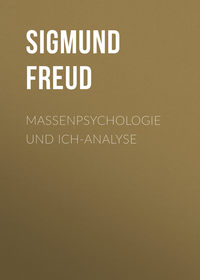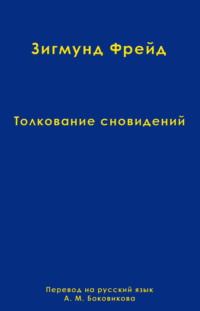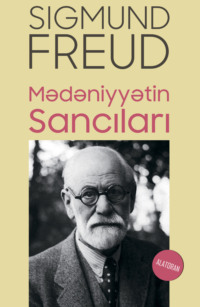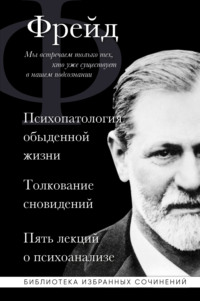
Полная версия
The Interpretation of Dreams / Толкование сновидений
Those authors who, like the influential philosopher Wundt, adopt a middle course do not fail to remark that in most dreams there is a co-operation of the somatic stimuli with the psychic instigators of the dream, the latter being either unknown or recognised as day interests.
We shall learn later that the riddle of the dream formation can be solved by the disclosure of an unsuspected psychic source of excitement. For the present we shall not be surprised at the over-estimation of those stimuli for the formation of the dream which do not originate from psychic life. It is not merely because they alone can easily be found and even confirmed by experiment, but the somatic conception of the origin of dreams thoroughly corresponds to the mode of thinking in vogue nowadays in psychiatry. Indeed, the mastery of the brain over the organism is particularly emphasized; but everything that might prove an independence of the psychic life from the demonstrable organic changes, or a spontaneity in its manifestations, is alarming to the psychiatrist nowadays, as if an acknowledgment of the same were bound to bring back the times of natural philosophy and the metaphysical conception of the psychic essence. The distrust of the psychiatrist has placed the psyche under a guardian, so to speak, and now demands that none of its feelings shall divulge any of its own faculties; but this attitude shows slight confidence in the stability of the causal concatenation which extends between the material and the psychic. Even where on investigation the psychic can be recognised as the primary course of a phenomenon, a more profound penetration will some day succeed in finding a continuation of the path to the organic determination of the psychic. But where the psychic must be taken as the terminus for our present knowledge, it should not be denied on that account.
(d) Why the Dream is Forgotten after Awakening. – That the dream “fades away” in the morning is proverbial. To be sure, it is capable of recollection. For we know the dream only by recalling it after awakening; but very often we believe that we remember it only incompletely, and that during the night there was more of it; we can observe how the memory of a dream which has been still vivid in the morning vanishes in the course of the day, leaving only a few small fragments; we often know that we have been dreaming, but we do not know what; and we are so well used to the fact that the dream is liable to be forgotten that we do not reject as absurd the possibility that one may have been dreaming even when one knows nothing in the morning of either the contents or the fact of dreaming. On the other hand, it happens that dreams manifest an extraordinary retentiveness in the memory. I have had occasion to analyse with my patients dreams which had occurred to them twenty-five years or more previously, and I can remember a dream of my own which is separated from the present day by at least thirty-seven years, and yet has lost nothing of its freshness in my memory. All this is very remarkable, and for the present incomprehensible.
The forgetting of dreams is treated in the most detailed manner by Strümpell.66 This forgetting is evidently a complex phenomenon; for Strümpell does not explain it by a single reason, but by a considerable number of reasons.
In the first place, all those factors which produce forgetfulness in the waking state are also determinant for the forgetting of dreams. When awake we are wont soon to forget a large number of sensations and perceptions because they are too feeble, and because they are connected with a slight amount of emotional feeling. This is also the case with many dream pictures; they are forgotten because they are too weak, while stronger pictures in proximity will be remembered. Moreover, the factor of intensity in itself is not the only determinant for the preservation of the dream pictures; Strümpell, as well as other authors (Calkins), admits that dream pictures are often rapidly forgotten, although they are known to have been vivid, whereas among those that are retained in memory there are many that are very shadowy and hazy. Besides, in the waking state one is wont to forget easily what happened only once, and to note more easily things of repeated occurrence. But most dream pictures are single experiences[7], and this peculiarity equally contributes towards the forgetting of all dreams. Of greater significance is a third motive for forgetting. In order that feelings, presentations, thoughts and the like, should attain a certain degree of memory, it is important that they should not remain isolated, but that they should enter into connections and associations of a suitable kind. If the words of a short verse are taken and mixed together, it will be very difficult to remember them. “When well arranged in suitable sequence one word will help another, and the whole remains as sense easily and firmly in the memory for a long time. Contradictions we usually retain with just as much difficulty and rarity as things confused and disarranged.” Now dreams in most cases lack sense and order. Dream compositions are by their very nature incapable of being remembered, and they are forgotten because they usually crumble together the very next moment. To be sure, these conclusions are not in full accord with the observation of Radestock54 (p. 168), that we retain best just those dreams which are most peculiar.
According to Strümpell, there are still other factors effective in the forgetting of dreams which are derived from the relation of the dream to the waking state. The forgetfulness of the waking consciousness for dreams is evidently only the counterpart of the fact already mentioned, that the dream (almost) never takes over successive memories from the waking state, but only certain details of these memories which it tears away from the habitual psychic connections in which they are recalled while we are awake. The dream composition, therefore, has no place in the company of psychic successions which fill the mind. It lacks all the aids of memory. “In this manner the dream structure rises, as it were, from the soil of our psychic life, and floats in psychic space like a cloud in the sky, which the next breath of air soon dispels” (p. 87). This is also aided by the fact that, upon awakening, the attention is immediately seized by the inrushing sensory world, and only very few dream pictures can withstand this power. They fade away before the impressions of the new day like the glow of the stars before the sunlight.
As a last factor favouring the forgetting of dreams, we may mention the fact that most people generally take little interest in their dreams. One who investigates dreams for a time, and takes a special interest in them, usually dreams more during that time than at any other; that is, he remembers his dreams more easily and more frequently.
Two other reasons for the forgetting of dreams added by Bonatelli (given by Benini3) to those of Strümpell have already been included in the latter; namely, (1) that the change of the general feeling between the sleeping and waking states is unfavourable to the mutual reproductions, and (2) that the different arrangement of the presentation material in the dream makes the dream untranslatable, so to speak, for the waking consciousness.
It is the more remarkable, as Strümpell observes, that, in spite of all these reasons for forgetting the dream, so many dreams are retained in memory. The continued efforts of the authors to formulate laws for the remembering of dreams amounts to an admission that here too there is something puzzling and unsolved. Certain peculiarities relating to the memory of dreams have been particularly noticed of late, e. g., that a dream which is considered forgotten in the morning may be recalled in the course of the day through a perception which accidentally touches the forgotten content of the dream (Radestock,54 Tissié68). The entire memory of the dream is open to an objection calculated to depreciate its value very markedly in critical eyes. One may doubt whether our memory, which omits so much from the dream, does not falsify what it retained.
Such doubts relating to the exactness of the reproduction of the dream are expressed by Strümpell when he says: “It therefore easily happens that the active consciousness involuntarily inserts much in recollection of the dream; one imagines one has dreamt all sorts of things which the actual dream did not contain.”
Jessen36 (p. 547) expresses himself very decidedly: “Moreover we must not lose sight of the fact, hitherto little heeded, that in the investigation and interpretation of orderly and logical dreams we almost always play with the truth when we recall a dream to memory. Unconsciously and unwittingly we fill up the gaps and supplement the dream pictures. Rarely, and perhaps never, has a connected dream been as connected as it appears to us in memory. Even the most truth-loving person can hardly relate a dream without exaggerating and embellishing it. The tendency of the human mind to conceive everything in connection is so great that it unwittingly supplies the deficiencies of connection if the dream is recalled somewhat disconnectedly.”
The observations of V. Eggers,20 though surely independently conceived, sound almost like a translation of Jessen̕s words: “…L̕observation des rêves a ses difficultés spéciales et le seul moyen d̕eviter toute erreur en pareille matière est de confier au papier sans le moindre retard ce que l̕on vient d̕éprouver et de remarquer; sinon, l̕oubli vient vite ou total ou partiel; l̕oubli total est sans gravité; mais l̕oubli partiel est perfide; car si l̕on se met ensuite à raconter ce que l̕on n̕a pas oublié, on est exposé à compléter par imagination les fragments incohérents et disjoints fourni par la memoire…; on devient artiste à son insu, et le récit, periodiquement répété s̕impose à la créance de son auteur, qui, de bonne foi, le présente comme un fait authentique, dûment établi selon les bonnes méthodes…”
Similarly Spitta,64 who seems to think that it is only in our attempt to reproduce the dream that we put in order the loosely associated dream elements: “To make connection out of disconnection, that is, to add the process of logical connection which is absent in the dream.”
As we do not at present possess any other objective control for the reliability of our memory, and as indeed such a control is impossible in examining the dream which is our own experience, and for which our memory is the only source, it is a question what value we may attach to our recollections of dreams.
(e) The Psychological Peculiarities of Dreams. – In the scientific investigation of the dream we start with the assumption that the dream is an occurrence of our own psychic activity; nevertheless the finished dream appears to us as something strange, the authorship of which we are so little forced to recognise that we can just as easily say “a dream appeared to me,” as “I have dreamt.” Whence this “psychic strangeness” of the dream? According to our discussion of the sources of dreams we may suppose that it does not depend on the material reaching the dream content; because this is for the most part common to the dream life and waking life. One may ask whether in the dream it is not changes in the psychic processes which call forth this impression, and may so put to test a psychological characteristic of the dream.
No one has more strongly emphasized the essential difference between dream and waking life, and utilised this difference for more far-reaching conclusions, than G. Th. Fechner25 in some observations in his Elements of Psychophysic (p. 520, part 11). He believes that “neither the simple depression of conscious psychic life under the main threshold,” nor the distraction of attention from the influences of the outer world, suffices to explain the peculiarities of the dream life as compared with the waking life. He rather believes that the scene of dreams is laid elsewhere than in the waking presentation life. “If the scene of the psychophysical activity were the same during the sleeping and the waking states, the dream, in my opinion, could only be a continuation of the waking ideation maintaining itself at a lower degree of intensity, and must moreover share with the latter its material and form. But the state of affairs is quite different.”
What Fechner really meant has never been made clear, nor has anybody else, to my knowledge, followed further the road, the clue to which he indicated in this remark. An anatomical interpretation in the sense of physiological brain localisations, or even in reference to histological sections of the cerebral cortex, will surely have to be excluded. The thought may, however, prove ingenious and fruitful if it can be referred to a psychic apparatus which is constructed out of many instances placed one behind another.
Other authors have been content to render prominent one or another of the tangible psychological peculiarities of the dream life, and perhaps to take these as a starting point for more far-reaching attempts at explanation.
It has been justly remarked that one of the main peculiarities of the dream life appears even in the state of falling asleep, and is to be designated as the phenomenon inducing sleep. According to Schleiermacher61 (p. 351), the characteristic part of the waking state is the fact that the psychic activity occurs in ideas rather than in pictures. But the dream thinks in pictures, and one may observe that with the approach of sleep the voluntary activities become difficult in the same measure as the involuntary appear, the latter belonging wholly to the class of pictures. The inability for such presentation work as we perceive to be intentionally desired, and the appearance of pictures which is regularly connected with this distraction, these are two qualities which are constant in the dream, and which in its psychological analysis we must recognise as essential characters of the dream life. Concerning the pictures – the hypnogogic hallucinations – we have discovered that even in their content they are identical with the dream pictures.
The dream therefore thinks preponderately, but not exclusively, in visual pictures. It also makes use of auditory pictures, and to a lesser extent of the impressions of the other senses. Much is also simply thought or imagined (probably represented by remnants of word presentations), just as in the waking state. But still what is characteristic for the dream is only those elements of the content which act like pictures, i. e. which resemble more the perceptions than the memory presentations. Disregarding all the discussions concerning the nature of hallucinations, familiar to every psychiatrist, we can say, with all well-versed authors, that the dream hallucinates, that is, replaces thoughts through hallucinations. In this respect there is no difference between visual and acoustic presentations; it has been noticed that the memory of a succession of sounds with which one falls asleep becomes transformed while sinking into sleep into an hallucination of the same melody, so as to make room again on awakening, which may repeatedly alternate with falling into a slumber, for the softer memory presentations which are differently formed in quality.
The transformation of an idea into an hallucination is not the only deviation of the dream from a waking thought which perhaps corresponds to it. From these pictures the dream forms a situation, it presents something in the present, it dramatises an idea, as Spitta64 (p. 145) puts it.[8] But the characteristic of this side of the dream life becomes complete only when it is remembered that while dreaming we do not – as a rule; the exceptions require a special explanation – imagine that we are thinking, but that we are living through an experience, i. e., we accept the hallucination with full belief. The criticism that this has not been experienced but only thought in a peculiar manner – dreamt – comes to us only on awakening. This character distinguishes the genuine sleeping dream from day dreaming, which is never confused with reality. The characteristics of the dream life thus far considered have been summed up by Burdach8 (p. 476) in the following sentences: “As characteristic features of the dream we may add (a) that the subjective activity of our mind appears as objective, inasmuch as our faculty of perception perceives the products of phantasy as if they were sensory activities… (b) sleep abrogates one̕s self-command, hence falling asleep necessitates a certain amount of passivity… The slumber pictures are conditioned by the relaxation of one̕s self-command.”
It is a question now of attempting to explain the credulity of the mind in reference to the dream hallucinations, which can only appear after the suspension of a certain arbitrary activity. Strümpell66 asserts that the mind behaves in this respect correctly, and in conformity with its mechanism. The dream elements are by no means mere presentations, but true and real experiences of the mind, similar to those that appear in the waking state as a result of the senses (p. 34). Whereas in the waking state the mind represents and thinks in word pictures and language, in the dream it represents and thinks in real tangible pictures (p. 35). Besides, the dream manifests a consciousness of space by transferring the sensations and pictures, just as in the waking state, into an outer space (p. 36). It must therefore be admitted that the mind in the dream is in the same relation to its pictures and perceptions as in the waking state (p. 43). If, however, it is thereby led astray, this is due to the fact that it lacks in sleep the criticism which alone can distinguish between the sensory perceptions emanating from within or from without. It cannot subject its pictures to the tests which alone can prove their objective reality. It furthermore neglects to differentiate between pictures that are arbitrarily interchanged and others where there is no free choice. It errs because it cannot apply to its content the law of causality (p. 58). In brief, its alienation from the outer world contains also the reason for its belief in the subjective dream world.
Delbœuf16 reaches the same conclusion through a somewhat different line of argument. We give to the dream pictures the credence of reality because in sleep we have no other impressions to compare them with, because we are cut off from the outer world. But it is not perhaps because we are unable to make tests in our sleep, that we believe in the truth of our hallucinations. The dream may delude us with all these tests, it may make us believe that we may touch the rose that we see in the dream, and still we only dream. According to Delbœuf there is no valid criterion to show whether something is a dream or a conscious reality, except – and that only in practical generality – the fact of awakening. “I declare delusional everything that is experienced between the period of falling asleep and awakening, if I notice on awakening that I lie in my bed undressed” (p. 84). “I have considered the dream pictures real during sleep in consequence of the mental habit, which cannot be put to sleep, of perceiving an outer world with which I can contrast my ego.”[9]
As the deviation from the outer world is taken as the stamp for the most striking characteristics of the dream, it will be worth while mentioning some ingenious observations of old Burdach8 which will throw light on the relation of the sleeping mind to the outer world and at the same time serve to prevent us from over-estimating the above deductions. “Sleep results only under the condition,” says Burdach, “that the mind is not excited by sensory stimuli… but it is not the lack of sensory stimuli that conditions sleep, but rather a lack of interest for the same; some sensory impressions are even necessary in so far as they serve to calm the mind; thus the miller can fall asleep only when he hears the rattling of his mill, and he who finds it necessary to burn a light at night, as a matter of precaution, cannot fall asleep in the dark” (p. 457).
“The psyche isolates itself during sleep from the outer world, and withdraws from the periphery… Nevertheless, the connection is not entirely interrupted; if one did not hear and feel even during sleep, but only after awakening, he would certainly never awake. The continuance of sensation is even more plainly shown by the fact that we are not always awakened by the mere sensory force of the impression, but by the psychic relation of the same; an indifferent word does not arouse the sleeper, but if called by name he awakens…: hence the psyche differentiates sensations during sleep… It is for this reason that we may be awakened by the lack of a sensory stimulus if it relates to the presentation of an important thing; thus one awakens when the light is extinguished, and the miller when the mill comes to a standstill; that is, the awakening is due to the cessation of a sensory activity, which presupposes that it has been perceived, and that it has not disturbed the mind, being indifferent or rather gratifying” (p. 460, etc.).
If we are willing to disregard these objections, which are not to be taken lightly, we still must admit that the qualities of the dream life thus far considered, which originate by withdrawing from the outer world, cannot fully explain the strangeness of the dream. For otherwise it would be possible to change back the hallucinations of the dream into presentations and the situations of the dream into thoughts, and thus to perform the task of dream interpretation. Now this is what we do when we reproduce the dream from memory after awakening, and whether we are fully or only partially successful in this back translation the dream still retains its mysteriousness undiminished.
Furthermore all the authors assume unhesitatingly that still other more far-reaching alterations take place in the presentation material of waking life. One of them, Strümpell,66 expresses himself as follows (p. 17): “With the cessation of the objectively active outlook and of the normal consciousness, the psyche loses the foundation in which were rooted the feelings, desires, interests, and actions. Those psychic states, feelings, interests, estimates which cling in the waking state to the memory pictures also succumb to… an obscure pressure, in consequence of which their connection with the pictures becomes severed; the perception pictures of things, persons, localities, events, and actions of the waking state are singly very abundantly reproduced, but none of these brings along its psychic value. The latter is removed from them, and hence they float about in the mind dependent upon their own resources…”
This deprivation the picture suffers of its psychic value, which again goes back to the derivation from the outer world, is according to Strümpell mainly responsible for the impression of strangeness with which the dream is confronted in our memory.
We have heard that even falling asleep carries with it the abandonment of one of the psychic activities – namely, the voluntary conduct of the presentation course. Thus the supposition, suggested also by other grounds, obtrudes itself, that the sleeping state may extend its influence also over the psychic functions. One or the other of these functions is perhaps entirely suspended; whether the remaining ones continue to work undisturbed, whether they can furnish normal work under the circumstances, is the next question. The idea occurs to us that the peculiarities of the dream may be explained through the inferior psychic activity during the sleeping state, but now comes the impression made by the dream upon our waking judgment which is contrary to such a conception. The dream is disconnected, it unites without hesitation the worst contradictions, it allows impossibilities, it disregards our authoritative knowledge from the day, and evinces ethical and moral dulness. He who would behave in the waking state as the dream does in its situations would be considered insane. He who in the waking state would speak in such manner or report such things as occur in the dream content, would impress us as confused and weak-minded. Thus we believe that we are only finding words for the fact when we place but little value on the psychic activity in the dream, and especially when we declare that the higher intellectual activities are suspended or at least much impaired in the dream.
With unusual unanimity – the exceptions will be dealt with elsewhere – the authors have pronounced their judgments on the dream – such judgments as lead immediately to a definite theory or explanation of the dream life. It is time that I should supplement the résumé which I have just given with a collection of the utterances of different authors – philosophers and physicians – on the psychological character of the dream.














